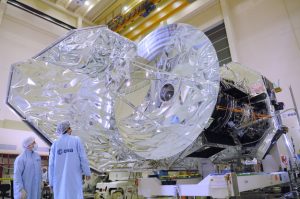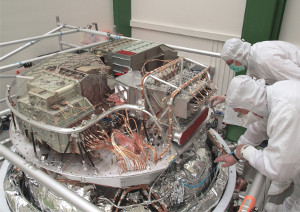
In the next few weeks Herschel is expected to finish its supply of helium coolant, which keeps its pioneering instruments cold enough to produce groundbreaking science. After nearly 4 years in operation, the operational life of this remarkable satellite is nearly over.
Launched in May 2009, Herschel has a 3.5m diameter mirror. This – the largest solid mirror ever launched – when combined with the sensitive instruments, makes Herschel the most powerful infrared space observatory ever flown in space. Being above the atmosphere allows it to span a vast range of wavelengths, from far-infrared to the sub-millimetre. The resulting studies of cold gas and dust have revealed the processes taking place in the first stages of the birth or stars, as well as galaxies billions of light years away.

A space observatory is nothing without its instruments, and Herschel is no exception. Two of the instruments, SPIRE and PACS, are combinations of cameras and spectrometers, allowing them to take amazing pictures and identify the molecules and compounds present in interstallar gas clouds. SPIRE was designed, built and operated by an international consortium, led by the UK, and assembled at STFC Rutherford Appleton Laboratory in Oxfordshire. The third instrument, HIFI, is an incredibly powerful spectrometer that allows finer analysis of the materials present, such as their detailed composition and any motion within gas clouds.
To detect the faint infrared glow of dust clouds, these instruments are cooled to within a fraction of a degree of absolute zero: a staggering -273 Celsius. To help them reach this temperature, they are housed within a giant vacuum flask, called a cryostat, along with a tank of superfluid liquid helium. It’s this helium which provides most of the cooling, but in doing so it gradually boils off, evaporating into space.

When it was launched, the tank was filled with 2300 litres of liquid helium – enough to last 3.5 years of operation in space, which equates to 20,000 hours of observation. Herschel has surpassed expectations, providing 10% more observations than predicted, and will continuing to do amazing science until every last drop of helium is gone. When the helium does run out the end will be quick, with the instruments warming up by several degrees – far beyond their operational requirements – in just a few hours. Confirmation of this will probably come during one of Herschel’s daily check-ins with earth.
Although the operational phase of Herschel is over the analysis of the data is still well underway, and if anything will increase as the depth of new discoveries is realised. The huge amount of data will have astronomers poring over it for years or decades to come, forming a lasting legacy from this remarkable satellite.
“It will be a sad day when Herschel makes its last observation,” said Cardiff University’s Matt Griffin, who leads the team behind the SPIRE instrument. “The data that it has collected during its lifetime will keep astronomers busy for years. For the next three years the SPIRE team will work hard to put all SPIRE data into the best possible condition to be as easy as possible to access and to use in the future”.
Once its observations have finished, Herschel will communicate with the ground for a month or so while engineers perform technical tests on the spacecraft and its instruments. Once those are complete, it will be placed in a stable parking orbit around the Sun and turned off.
“We will finish observing soon, but Herschel data will enable a vast amount of exciting science to be done for many years to come,” says Göran Pilbratt, ESA’s Herschel Project Scientist at ESA’s European Space Research and Technology Centre in Noordwijk, the Netherlands. “In fact, the peak of scientific productivity is still ahead of us, and the task now is to make the treasure trove of Herschel data as valuable as possible for now and for the future.”
